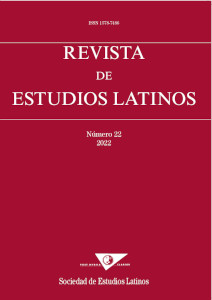Image formation processes in memory arts (1485-1520)
DOI:
https://doi.org/10.23808/rel.v22i0.96952Keywords:
ars memorativa, similitudo, comparatio, figmentum, inscriptio, imagoAbstract
In memory arts, images are symbols that encode what someone wants to remember. The processes to build this type of mental images are very varied. For this reason, we have tried to systematize them here, classifying them into four basic processes: similitudo, comparatio, figmentum and inscriptio, depending on the quality of what is going to be encoded. To define, compare and exemplify these procedures, we will use various handbooks of the ars memorativa from what is regarded as its period of greatest splendour, 1485-1520. In addition, we will analyse different examples of how they are realized and we will consider other additional resources, such as the colligantia and the notae, which serve to specify the meaning of the image and to connect it to the rest of the symbols.
Downloads
References
Fuentes
de Aquino, T. (1862): Divi Thomas Aquinatis Summa theologica cum Indices, Migne, J. P. (ed.). (1862). París.
de Arce draconis, M (2016): Ars memorativa. Kiss, F. G., Dolezalová, L. y Wójcik R. (eds.), The Art of Memory in Late Medieval Central Europe (Czech Land, Hungary, Poland), París, L’Harmattan.
Baldovinus s abaudiensis (1489): Ars memoriae [Junto con Publicius, J. Ars memorativa], Lugduni, Johannes de Prato.
Colineus, J. (1515): De memoria artificiosa compendiosum opusculum: partim ex Cicerone et Quintiliano, partim ex divo Thoma Aquinate conflatum, París, Badius Ascensius.
Cusanus, J. (1514): Tractatulus artificiose memorie, Viena, Hieronymus Vietor y Johannis Singrienius.
Leporeo, G. (2016): El Ars Memorativa de G. Leporeo (Estudio, edición crítica,
traducción, notas e índices). Morcillo Romero, J. J. (2016) [Tesis doctoral], Cáceres, Servicio de Publicaciones de la Universidad de Extremadura.
De memoria fecunda. (1425): Pack (ed.) (1979). «An Ars memorativa from the Late Middle Ages», Archives d’histoire doctrinale et littéraire du Moyen Age, 46, 221-275.
Merino, L. (2007): Retórica y artes de memoria en el humanismo renacentista. Jorge
de Trebisonda, Pedro de Rávena y Francisco Sánchez de las Brozas, Cáceres, Servicio de Publicaciones de la Universidad de Extremadura.
Murner, T. (2017): El juego de cartas de lógica, Traducción, introducción y notas de Jorge Medina. Prólogo de Mauricio Beuchot, Ciudad de México, Sapientia.
Petrus Coloniae (ca. 1520): Ars memorativa. [Lugar y editor desconocidos].
Philippus, J. (1515): Ars memorativa naturali, Núremberg, Fridericus Peypus.
Publicio, J. (1485): Oratoriae artis epitomata, Venecia, Erhardus Ratdolt.
Romberch, J. (1520): Congestorium artificiosae memoriae, Venecia, Georgius de Rusconibus.
Simonis, N. (1510): Ludus artificialis oblivionis, Leipzig.
Surgant, J. (1508): Manuale curatorum predicandi, Maguncia, Iohannis Schaffer.
Umhauser, C. (1501): Ars memorative S. Thome, Ciceronis, Quintiliani, Petri Ravenne, Núremberg, Ambrosius Hueber.
Weczdorff de triptis, I. (ca. 1501): Ars memorandi. [Lugar y editor desconocidos]
Estudios
Berthoz, A. y Scheid, J. (eds.) (2018): Les arts de la mémoire et les images mentales, París, Collège de France.
Bolzoni, L. (1995): La stanza della memoria, Turín, Giulio Einaudi Editore.
Chiappetta, A. (2015): «Algumas notas sobre imagem e palavra na Arte da Memória», Letras Clássicas 19, 54-68.
Coleman, J. (1992): Ancient and Medieval memories, Nueva York, Cambridge University Press.
Doležalová, L., WoJ cik, R. y Kiss, F. G. (eds.) (2016): The art of memory in Late Medieval Central Europe (Czech Land, Hungary, Poland), París, L’Harmattan.
Eco, U. (1976): Il segno, Milán, ISEDI.
Eco, U (1992): «Mnemotecniche come semiotiche», en Bolzoni, L. y Corsi, P. (eds.), La cultura della memoria, Bolonia, Società editrice il Mulino, 35-56.
Merino, L. (2002): «Retórica y memoria artificial: de la Antigüedad al Renacimiento», en Bernat, A. y Cull, J. T. (eds.), Los días del Alción. Emblemas, literatura y arte del Siglo de Oro, Barcelona, Medio Maravedí, 387-400.
Merino, L. (2015): «Notatae similitudines/ notae similitudines: de la Rhetorica ad Herennium al Ars memorativa», Revista de Estudios Latinos (RELAT) 15, 97-111.
Merino, L. (2020): «Iacobus Publicius’s Ars memorativa. An approach to the history of the printed text», Acta Universitatis Carolinae Philologica 2; Graecolatina Pragensia, 85-105.
Merino, L. (2021): «Shedding light on the textual genesis of Jacobus Publicius’ Ars memorie (MS London, BL, Add. 28805)», Daphnis 50, 85-127.
Mittelberg, I. (2002): «The visual memory of grammar: iconographical and metaphorical insights», Metaphorik 2, 69-89.
Morcillo, J. J. (2012): «Los alfabetos visuales en la memoria artificial. De ordo locorum a memoria verborum», Myrtia 27, 73-88.
Rossi, P. (1960): Clavis universalis, Londres, Bloomsbury Publishing.
Taylor, R. (1987): El arte de la memoria en el Nuevo Mundo, Madrid, Swan
Volkmann, L. (1929): Ars memorativa, Viena, A. Schroll.
Yates, F. (1966): The art of memory, Londres, Routledge Kegan Paul.
Downloads
Published
How to Cite
Issue
Section
License
Copyright (c) 2022 Revista de Estudios Latinos

This work is licensed under a Creative Commons Attribution-NonCommercial-NoDerivatives 4.0 International License.
The originals published in the printed and electronic editions of this journal are the property of the Revista de Estudios Latinos and can be circulated as long as the original source and authorship is made clear in any reproduction, full or partial, of the same, and as long as this is not done for commercial purposes.






